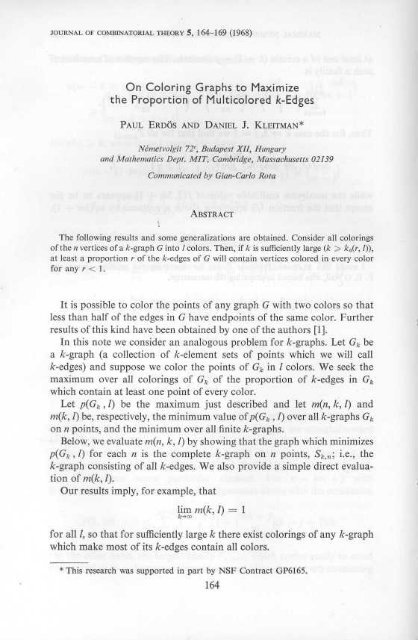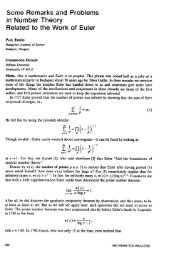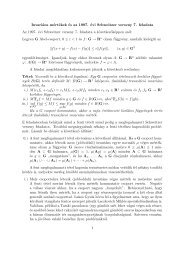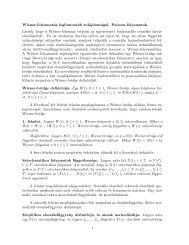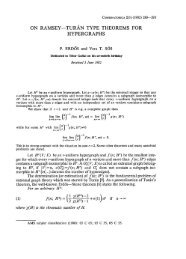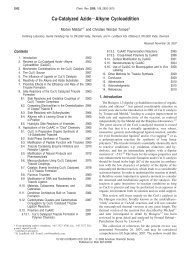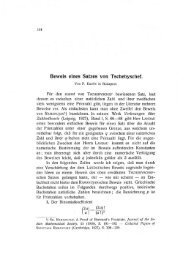It is possible to color the points of any graph G with two colors so that ...
It is possible to color the points of any graph G with two colors so that ...
It is possible to color the points of any graph G with two colors so that ...
You also want an ePaper? Increase the reach of your titles
YUMPU automatically turns print PDFs into web optimized ePapers that Google loves.
JOURNAL OF COMBINATORIAL THEORY 5, 1 ĺ4- 1ĺ9 (19ĺĺ)<br />
On Coloring Graphs <strong>to</strong> Maximize<br />
<strong>the</strong> Proportion <strong>of</strong> Multi<strong>color</strong>ed k-Edges<br />
PAUL ERDŐS AND DANIEL J. KLEITMAN *<br />
Németvolgit ĺ21 , Budapest XII, Hungary<br />
and Ma<strong>the</strong>matics Dept . MIT, Cambridge, Massachusetts 02139<br />
Communicated by Gian-Carlo Rota<br />
ABSTRACT<br />
The following results and <strong>so</strong>me generalizations are obtained . Consider all <strong>color</strong>ings<br />
<strong>of</strong> <strong>the</strong> n vertices <strong>of</strong> a k-<strong>graph</strong> G in<strong>to</strong> l <strong>color</strong>s . Then, if k <strong>is</strong> sufficiently large (k > k„(r, 1)),<br />
at least a proportion r <strong>of</strong> <strong>the</strong> k-edges <strong>of</strong> G will contain vertices <strong>color</strong>ed in every <strong>color</strong><br />
for <strong>any</strong> r
where S2 (k, l) <strong>is</strong> a Stirling number <strong>of</strong> <strong>the</strong> second kind, i .e ., <strong>the</strong> number <strong>of</strong><br />
partitions <strong>of</strong> k elements in<strong>to</strong> exactly I ind<strong>is</strong>tingu<strong>is</strong>hable parts .<br />
THEOREM 2 . For <strong>any</strong> (n, k,1), <strong>the</strong> minimum value <strong>of</strong> p(G k , l) <strong>is</strong> achieved<br />
if Gk <strong>is</strong> <strong>the</strong> complete k-<strong>graph</strong> on n <strong>points</strong> .<br />
and<br />
Our results can be divided in<strong>to</strong> <strong>the</strong> following three parts :<br />
THEOREM 1 . For <strong>any</strong> finite <strong>graph</strong><br />
COLORING GRAPHS<br />
m(n k 1) > S2 (~' I) 1 !<br />
COROLLARY . For <strong>any</strong> (n, k, I) such <strong>that</strong> l divides n, we have<br />
a (l s)<br />
n<br />
m(n, k, l) _ ( -l)S(l t<br />
s) n 1 , n)<br />
s=o k<br />
m(k, l)<br />
S(k,1)l!<br />
lk<br />
PROOF OF THEOREM 1 : There are I n d<strong>is</strong>tinct <strong>color</strong>ings <strong>of</strong> a <strong>graph</strong> on<br />
n, <strong>points</strong> in<strong>to</strong> l <strong>color</strong>s . Of <strong>the</strong>se, In -kR <strong>color</strong>ings will <strong>color</strong> a given k-tuple<br />
in exactly l <strong>color</strong>s, where R <strong>is</strong> <strong>the</strong> number <strong>of</strong> ways <strong>of</strong> <strong>color</strong>ing k <strong>points</strong> in<br />
exactly l <strong>color</strong>s . Moreover, R <strong>is</strong> clearly I! times <strong>the</strong> number <strong>of</strong> partitions<br />
<strong>of</strong> k in<strong>to</strong> exactly I non-empty parts, which latter number <strong>is</strong> S 2 (k, 1) . The<br />
proportion <strong>of</strong> all <strong>color</strong>ings which will give r<strong>is</strong>e <strong>to</strong> all /-<strong>color</strong>s in <strong>any</strong> k-tuple<br />
<strong>is</strong> <strong>the</strong>n<br />
1!<br />
S2 (k, l) .<br />
Let G k have q(Gk) k-edges, and let r(C, G k ) be <strong>the</strong> number <strong>of</strong> edges <strong>of</strong><br />
G k <strong>color</strong>ed in all l <strong>color</strong>s under <strong>the</strong> <strong>color</strong>ing C . Let B(C, E) be 1 if <strong>the</strong> edge<br />
E <strong>is</strong> <strong>color</strong>ed in all <strong>color</strong>s by C and 0 o<strong>the</strong>rw<strong>is</strong>e .<br />
We <strong>the</strong>n have<br />
r(C, G k) _ Y e(C, E) .<br />
EEG,<br />
By <strong>the</strong> remarks above, for <strong>any</strong> edge E, <strong>the</strong> average value <strong>of</strong> B(C, E) over<br />
all <strong>color</strong>ings <strong>is</strong> given by<br />
1k S,(k, 1) .<br />
1 ĺ 5
1ĺĺ ERDŐS AND KLEITMAN<br />
Averaging <strong>the</strong> expression above for r over all <strong>color</strong>ings in<strong>to</strong> l <strong>color</strong>s <strong>the</strong>n<br />
yields<br />
lk S2 (k, l) .<br />
PROOF OF THEOREM 2 : For a <strong>color</strong>ing C <strong>of</strong> a <strong>graph</strong> G k on n <strong>points</strong><br />
and an element g <strong>of</strong> <strong>the</strong> symmetric group Sn on <strong>the</strong> n <strong>points</strong> <strong>of</strong> Gk , let Cg<br />
be <strong>the</strong> <strong>color</strong>ing obtained by performing <strong>the</strong> permutation g before <strong>the</strong><br />
<strong>color</strong>ing C. For <strong>any</strong> k-edge E, let Eg be <strong>the</strong> k-edge whose elements are <strong>the</strong><br />
images <strong>of</strong> <strong>the</strong> elements <strong>of</strong> E under g, and let Gkg be <strong>the</strong> k-<strong>graph</strong> whose<br />
members are <strong>of</strong> <strong>the</strong> form Eg for each E in G k .<br />
For <strong>any</strong> <strong>color</strong>ing and <strong>any</strong> edge we have<br />
hence<br />
B(C, E) = B(Cg, Eg)<br />
r(C, Gk) = r(Cg, Gkg)-<br />
Using <strong>the</strong>se facts, we find, upon averaging r(Cg, G,.) over all g in Sn , <strong>that</strong><br />
<br />
since each edge E lies in Gk9-1 for exactly n!q(Gk)l(k) elements g <strong>of</strong> S,, .<br />
E
Th<strong>is</strong> latter expression tells us <strong>that</strong><br />
COLORING GRAPHS<br />
,,Slg(Gk)<br />
<strong>is</strong> independent <strong>of</strong> G k and in fact <strong>is</strong> given by r(C,Sĺ,,n)/(;) since, for G k = Sk,n,<br />
<strong>the</strong> averaging <strong>is</strong> trivial .<br />
Now, if p(G ĺr , l) < p(Sk , n , l), <strong>the</strong>re must be a <strong>color</strong>ing C such <strong>that</strong><br />
r(C, Gk)19(Gĺ,) < r(C, Sk .n) /(k)'<br />
But by <strong>the</strong> result immediately above <strong>the</strong>re must <strong>the</strong>n be <strong>so</strong>me g c S,, such<br />
<strong>that</strong><br />
r(Cg, Gk)lq(Gk) > r(C,sk,n)/(k) ;<br />
thus, for all G k , p(Gk , l) > p(Sĺr,n , l) .<br />
PROOF OF COROLLARY : For <strong>the</strong> complete <strong>graph</strong> one can easily verify<br />
<strong>that</strong> <strong>any</strong> <strong>color</strong>ing C which assigns exactly [n/l] or [n/l] + 1 <strong>points</strong> <strong>to</strong> each<br />
<strong>color</strong> will sat<strong>is</strong>fy r(C, Sk , n) = m(n, k, l) . The value <strong>of</strong> m(n, k, l) can<br />
immediately be deduced from th<strong>is</strong> fact ; by <strong>the</strong> principle <strong>of</strong> inclusionexclusion,<br />
we obtain<br />
m(n, k, l) -<br />
a<br />
1)3 ( S ) (n(1 k s)ll<br />
)/(k)'<br />
S=o<br />
For large values <strong>of</strong> n th<strong>is</strong> expression <strong>is</strong> asymp<strong>to</strong>tic <strong>to</strong> and always greater<br />
than<br />
( -1)s(S)(I-S),//k .<br />
An elementary identity for <strong>the</strong> Stirling numbers,<br />
S=0<br />
Sz(k l) - (- 1) i ' (-1)e tk<br />
t=o t!(k - t)! '<br />
implies <strong>that</strong> <strong>the</strong> upper limit for m(k, l) obtained here <strong>is</strong> <strong>the</strong> same as <strong>the</strong><br />
bound obtained in Theorem 1 .<br />
Our Theorem 2 above <strong>is</strong> capable <strong>of</strong> wide generalization . In fact, <strong>the</strong><br />
method <strong>of</strong> pro<strong>of</strong> used above applies <strong>to</strong> <strong>any</strong> situation in which we seek <strong>to</strong><br />
minimize over a class <strong>of</strong> <strong>graph</strong>s <strong>the</strong> maximum over <strong>any</strong> class <strong>of</strong> <strong>color</strong>ings<br />
<strong>that</strong> <strong>is</strong> symmetric under point permutation, <strong>the</strong> proportion <strong>of</strong> <strong>the</strong> edges<br />
possessing <strong>any</strong> property which <strong>is</strong> invariant under point permutation .<br />
Th<strong>is</strong> generalization can be expressed as <strong>the</strong> following <strong>the</strong>orem .<br />
1ĺĺ
1 ĺ ĺ<br />
ERDŐS AND KLEITMAN<br />
THEOREM 3 . Let Gk be a k-<strong>graph</strong> and C, a class <strong>of</strong> <strong>color</strong>ings <strong>of</strong> <strong>the</strong><br />
<strong>points</strong> or, for m < k, <strong>of</strong> <strong>the</strong> m edges <strong>of</strong> G k . Let ĺr be a property <strong>of</strong> <strong>color</strong>ed<br />
k-edges . (We say an edge E has property Tr for <strong>color</strong>ing C if B(E, C) = 1 .)<br />
Let p(Gk , CL) be <strong>the</strong> maximum over all <strong>color</strong>ings in C, <strong>of</strong> <strong>the</strong> proportion<br />
<strong>of</strong> k-edges in G k which have property ĺr . Let m(n, k, C i) be <strong>the</strong> minimum<br />
value <strong>of</strong> p(G k , C) over all k-<strong>graph</strong>s on n <strong>points</strong> . Then, if <strong>the</strong> class C, <strong>is</strong><br />
symmetric under point interchange, and <strong>the</strong> property ĺr <strong>is</strong> invariant under<br />
simultaneous permutation <strong>of</strong> <strong>color</strong>ing and edge (<strong>so</strong> <strong>that</strong> S,, g e S,,<br />
9(E, C) = B(Eg, Cg)),<br />
m(n, k, Cl ) = p(Sk ,,,, Ca)<br />
where Sk, <strong>is</strong> <strong>the</strong> complete k-<strong>graph</strong> on n <strong>points</strong> .<br />
The pro<strong>of</strong> <strong>of</strong> th<strong>is</strong> <strong>the</strong>orem <strong>is</strong> <strong>the</strong> same as <strong>that</strong> <strong>of</strong> Theorem 2 .<br />
We can apply <strong>the</strong> generalization <strong>to</strong> obtain answers <strong>to</strong> <strong>the</strong> following<br />
modifications <strong>of</strong> our original problem .<br />
(a) Let<br />
~M(n, k,/,r) ,<br />
m(n, k, 1, r ;)<br />
be <strong>the</strong> minimax, <strong>that</strong> <strong>is</strong>, <strong>the</strong> minimum over k-<strong>graph</strong> <strong>of</strong> <strong>the</strong> maximum over<br />
all <strong>color</strong>ings <strong>of</strong> <strong>points</strong> in I <strong>color</strong>s, <strong>of</strong> <strong>the</strong> proportion <strong>of</strong> edges <strong>color</strong>ed in<br />
at least r <strong>color</strong>s .<br />
exactly<br />
(b) Let m(n, k, l, s s) be <strong>the</strong> minimax over <strong>graph</strong> <strong>color</strong>ings <strong>of</strong> <strong>the</strong><br />
proportion <strong>of</strong> edges such <strong>that</strong> s ; <strong>points</strong> per edge are <strong>color</strong>ed in <strong>color</strong> j .<br />
(c) Let m(n, k, l, s,, ,. . ., s l , t, , . . ., t t ) be <strong>the</strong> minimax over <strong>graph</strong> <strong>color</strong>ings<br />
in n <strong>points</strong> for which t; edges are <strong>color</strong>ed in <strong>color</strong> j, <strong>of</strong> <strong>the</strong> proportion <strong>of</strong><br />
edges such <strong>that</strong> s; <strong>points</strong> per edge are <strong>color</strong>ed in <strong>color</strong> j.<br />
The possibilities <strong>of</strong> fur<strong>the</strong>r variation in th<strong>is</strong> problem are obviously<br />
great . In each case above we can conclude <strong>that</strong> <strong>the</strong> minimum-maximum<br />
occurs for <strong>the</strong> complete <strong>graph</strong> Sk , n , for which <strong>to</strong> answer <strong>to</strong> each <strong>of</strong> <strong>the</strong>se<br />
questions becomes a routine computation .<br />
The conclusion <strong>that</strong> limk,- m(k, l) = 1. has been used by C . Jockusch [2]<br />
in proving <strong>the</strong> following result in recursion <strong>the</strong>ory, nomenclature for<br />
which will not be defined here .<br />
The sets <strong>with</strong> <strong>the</strong> property <strong>that</strong> <strong>so</strong>me set <strong>of</strong> lesser degree <strong>of</strong> un<strong>so</strong>lvability<br />
<strong>is</strong> strongly hyper-hyperimmune have zero measure . Th<strong>is</strong> result implies<br />
<strong>that</strong> <strong>the</strong> measure <strong>of</strong> <strong>the</strong> family <strong>of</strong> sets, each one <strong>of</strong> which <strong>is</strong> Turing equiva-
COLORING GRAPHS 1 ĺ 9<br />
lent <strong>to</strong> <strong>so</strong>me member <strong>of</strong> a given downward closed family C, <strong>is</strong> <strong>the</strong> same as<br />
<strong>the</strong> measure <strong>of</strong> <strong>the</strong> family whose members each have <strong>so</strong>me member <strong>of</strong> C<br />
recursive in it. A downward closed family here means a family <strong>of</strong> infinite<br />
sets such <strong>that</strong> every infinite subset <strong>of</strong> every member <strong>is</strong> al<strong>so</strong> a member .<br />
REFERENCES<br />
I . P. ERDÖS, On The Structure <strong>of</strong> Linear Graphs, Israel Journal <strong>of</strong> Math 1(19ĺ3), 5ĺ-ĺ0 .<br />
ĺ . C. JOCxuscH, (<strong>to</strong> be publ<strong>is</strong>hed) .<br />
;ĺ2Í51z-G


